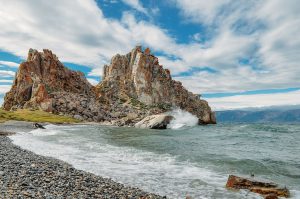
Not only having beautiful historical buildings that are spread all over Saint Petersburg, Russia is also blessed with amazing nature. Given such a vast landmass called home, Russia has diverse conditions of nature from the ever snowy mountain regions to the semi-desert fringing the Caspian Sea. The country’s wildlife is also rich and unique with some flora and fauna exclusively belong to Russia. Many people visit the country for many reasons, and one of them is to enjoy its nature. If you are looking for a list of places to see in Russia to quench you thirst for fresh air and greens to spoil your eyes, here are 5 photogenic Russian national parks you can try and visit.
1. Losiny Ostrov
Located in Moscow and Moscow Oblast, this national park is the first in Russia and covers 116.21 square kilometers of the land with 83% of the area occupied by forest and the rest by water and swamp. However, not all part of the park is open for public since it is divided into three:
- Protected region, 53.94 square kilometers or 47% of the park, is closed to the public,
- For excursion and sport, 31.30 square kilometers or 27% of the park, is open with limits and restrictions,
- For recreational purposes, 29.81 square kilometers or 26% of the park, is open for mass.
The most photogenic part of the Losiny Ostrov is on the southwest region of the park where you can see the terraces of the Yauza River. The main feature of the park is the herds of moose, as the park is named after this animal. Other than moose, there are over 240 more species of animals inhabit the place. You can enjoy a 4-hour tour around the park that includes bio station visit, horse riding, and lunch in a Russian hut.
2. Nizhnyaya Kama
This national park was established on April 20, 1991 in the center of Russia, in Tukayevsky and Yelabuzhsky Districts of Tatarstan to be exact, to protect coniferous forests located at the banks of the Kama River. The whole park covers 265.87 square kilometers of land that becomes the home to over 190 species of birds, 6 species of reptiles, 10 species of amphibians, 16 species of fish, and big mammals such as moose, deer, badger, lynx, and many more. Pine is the most common plant to be found in Nizhnyaya Kama followed by birch and aspen. There are so many excursion routes that the visitors could choose from, depends on what they want to see.
- Krasnaya Gorka near Elabuga is the route to enjoy the panoramic view of the Kama River Valley. In clear weather, on the horizon, the bell towers of churches and minarets of the Elabuga mosques, the emerald silhouette of the Big Bor, the twisting channel of the Kama and the reflection of hundreds of floodplain lakes are clearly distinguishable. For the beauty and perfection of these places this tract is called “Red Hill”.
- Holy Key near Elabuga is the route for them who wish to pass through the pine forest. In general, the tour introduces visitors to both the historical past of the forest, as well as its unique ecosystems, flora and fauna. The bridges and the road are paved with rubble throughout (a kind of natural limestone).
- Big Bor route will take the visitors on a journey through one of the most typologically and floristically rich forests preserved on the territory of the Republic of Tatarstan – the Big Bor. Located on the watershed of the Kama River and the small Toyma River, which is a natural monument, the Big Bor has many places of interest that tourists can get to know such as; Bogaty, Raspberry, Tulapin, Maly Erkhov, Bolshoi Erkhov, extending up to 2 km into the forest. These are the forest ecosystems least changed by human activity. It is here that the 150-year-old giant pines, the 100-year-old beautiful firs and linden-old-timers are easy to be spotted.
3. Nechkinsky
The Nechkinskiy National Park is in the network of specially protected natural territories of the Udmurt Republic as one of the most valuable wildlife reserves, where unique massifs of floodplain forests, river, lake and marsh ecosystems, wildlife of forests, natural, historical and cultural complexes and objects of the Middle Prikamye are preserved. It is located in the southeastern part of the Udmurt Republic, in the territory of three administrative regions: Votkinsk, Zavyalovsky and Sarapul. The territory of the national park is located at the junction of three climatic zones: taiga, broad-leaved forests and forest-steppe.
4. Pribaikalsky
This national park offers a different view from the other three above as it covers the southwest coast of Lake Baikal in southeastern Siberia. Here you can see the coastal strip that includes offshore islands and mountain ridges. Pribaikalsky is a major component of the UNESCO World Heritage Site, which becomes the reason why tourists are not allowed to freely enter the park. There is a permission to attain and rules to follow. There are several most picturesque parts of the park which include Cliff Screeper, Cliff Tea, Aya Bay, Rock Sagan-Zaba, Cape Sagan-Khushun, Cape Khoboy, Cave Chapel, and Rocks of Tazheran massif. Other than tourists, this national park also welcomes volunteers, teachers, and specialists.
5. Russian Arctic
If you want to experience the vast land covered in snow, the highlands, spotting polar bears, then this is the national park for you. Located in a large and remote area of the Arctic Ocean, the northern part of Severny Island, and Franz Josef Land, it covers around 74,000 square kilometers of area divided into land and sea. Other than polar bears, you can also see bowhead whales, walrus, and seal rookeries.
Those are the 5 of the most photogenic national parks in Russia that you can visit if you are a true nature lovers who are also eager to see the beautiful parts of the country.
